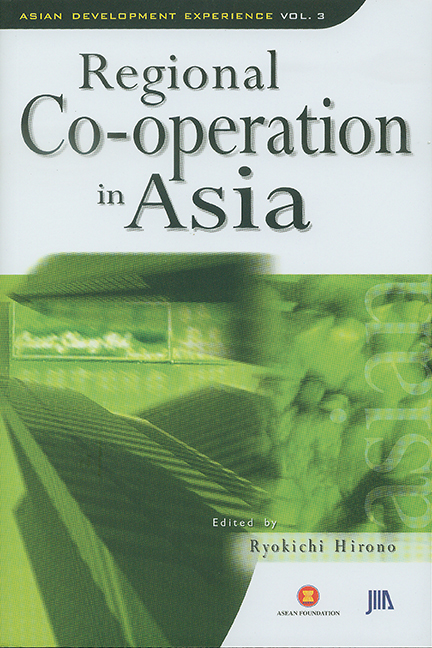Book contents
- Frontmatter
- Contents
- List of Tables
- List of Figures
- List of Contributors
- Acknowledgements
- 1 Structural Changes and Domestic Reforms in Singapore: Challenges and Implications to Regional Co-operation in ASEAN and East Asia
- 2 Asia-Japan Co-operation Toward East Asian Integration
- 3 The Impact of External Changes and Japan's Role in Industrializing Thailand
- 4 Confronting Regionalism in Asia: A View from the Philippines
- 5 Japan's Role in ASEAN-10 Under Globalization: A Japanese Perspective
- OTHER BOOKS IN THIS SERIES
2 - Asia-Japan Co-operation Toward East Asian Integration
Published online by Cambridge University Press: 21 October 2015
- Frontmatter
- Contents
- List of Tables
- List of Figures
- List of Contributors
- Acknowledgements
- 1 Structural Changes and Domestic Reforms in Singapore: Challenges and Implications to Regional Co-operation in ASEAN and East Asia
- 2 Asia-Japan Co-operation Toward East Asian Integration
- 3 The Impact of External Changes and Japan's Role in Industrializing Thailand
- 4 Confronting Regionalism in Asia: A View from the Philippines
- 5 Japan's Role in ASEAN-10 Under Globalization: A Japanese Perspective
- OTHER BOOKS IN THIS SERIES
Summary
Introduction
ASEAN and Japan have played a critical, if not a pivotal, role in the establishment of regional co-operation processes in the Asia Pacific region. At the inter-governmental level the region has seen the establishment of APEC (Asia Pacific Economic Co-operation) to promote economic cooperation and the ARF (ASEAN Regional Forum) as a forum for co-operation in the political and security field to strengthen confidence building measures (CBMs). At the non-governmental level, two important “track two” processes have also emerged in the region, beginning with PECC (Pacific Economic Co-operation Council) since the early 1980s and later CSCAP (Council for Security Co-operation in the Asia Pacific). The overarching objective of these processes is to develop an Asia Pacific community.
Will ASEAN and Japan again play an important role in the creation of an East Asian community? ASEAN has made the first step toward this end by initiating the ASEAN Plus Three (APT) process, involving the ten ASEAN countries, China, Japan and South Korea. A vision for an East Asian community has been articulated by the East Asian Vision Group (EAVG) in its report, “Towards an East Asian Community”, submitted to the APT Leaders at their Fifth Summit in Brunei Darussalam in November 2001. The vision is of an East Asia that moves “from a region of nations to a bona fide regional community with shared challenges, common aspirations, and a parallel destiny”. Furthermore, the report also stated that “[t]he economic field, including trade, investment, and finance, is expected to serve as the catalyst in the comprehensive community-building process”.
In the field of economic co-operation, the vision is that of a progressive integration of the East Asian economy, ultimately leading to an East Asian economic community. Economic integration is to be pursued through the liberalization of trade and investment, development and technological co-operation, and information technology development.
In trade, it recommended the formation of an East Asia Free Trade Area (EAFTA), and the liberalization of trade should be well ahead of the Bogor Goal set by APEC. In investment, it proposed the establishment of an East Asian Investment Area (EAIA) by expanding the Framework Agreement on ASEAN Investment Area (AIA) to cover East Asia as a whole. In the area of finance, the recommendation toward greater financial integration was to adopt a staged, two-track approach, namely for the establishment of a self-help arrangement.
- Type
- Chapter
- Information
- Asian Development ExperienceRegional Co-operation in Asia, pp. 24 - 49Publisher: ISEAS–Yusof Ishak InstitutePrint publication year: 2004

